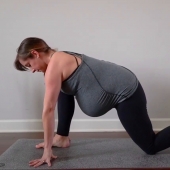Exercise can prepare your body for an easier – and perhaps quicker – delivery, and it can help you return to your pre-baby weight sooner. If you weren’t active before pregnancy, there’s no time like the present to get moving. Whether you’re new to exercise or an old pro, here are five exercises and techniques you can use to prepare your body for labor and delivery.
1. Child’s pose: This yoga pose helps lengthen pelvic floor muscles and ease discomfort. Kneel down and sit on your heels. Then lean forward slowly and walk your arms out long in front of you. Breathe deeply. You also can rest your elbows on the ground in front of you with your hands supporting your head. As your belly grows, you may need to spread your knees farther apart to create space. If it’s uncomfortable to sit your backside on your heels, you can sit up higher. Take care to not raise your hips above your heart. Talk to your physical therapist for other guidelines specific to you.
2. Deep squat: Deep squats help relax and lengthen the pelvic floor muscles and stretch the perineum. Stand with your legs wider than hip width. Slowly squat down as far as you can go with your hands pressed together in front of you. Your physical therapist can talk with you about how often and how many deep squats you should do.
3. Quadruped cat/cow: This yoga pose helps ease discomfort and decrease lower back pain. Get on your hands and knees. Exhale and round your back as you tuck your chin toward your chest. Then inhale and gently arch your back downward and look up at the sky.
4. Perineal bulges: This trains you to push during delivery without holding your breath. Holding your breath while pushing is call Valsalva. Valsalva can decrease the rate of blood flow back to the heart, lower maternal blood pressure, decrease maternal blood oxygen and blood flow to the placenta, and increase the risk for injury. It also can increase fetal head compression and fetal distress.
Perineal bulges should only be practiced in the last three weeks of pregnancy. Don’t practice them often because it can place excessive pressure on your pelvic floor structures.
Don’t practice perineal bulges if you have premature rupture of the membranes, vaginal bleeding during pregnancy, or pelvic organ prolapse. Talk with your doctor and physical therapist before starting perineal bulges. They can guide you in best practices and how often to do them.
When you practice perineal bulges, do it in your planned labor and delivery positions. Sit on a small towel running length-wise from front to back. Gently press your perineal body, or the area between the vagina and rectum, into the towel. Think about gently moving the sit bones – the bones you can feel in your glutes – apart and moving the tailbone away from the pubic bone.
You also can use a mirror to make sure the perineum is bulging out and down, not up and in, which is a Kegel and the opposite of what should be performed during delivery.
5. Perineal massage: Perineal massage lengthens and softens the tissues of the perineum. You can start this at 35 weeks of pregnancy. Perform this massage technique for 10 minutes once a day. Take a warm bath or hold a warm compress on the perineum for 10 minutes to help you relax before the massage.
Sit or lean back in a comfortable position. Put a water soluble lubricant on your thumbs and perineum. Place your thumbs 1 to 1.5 inches inside your vagina. Press downward toward the rectum and to the sides until you feel a slight burning, stinging, or tingling sensation. Hold the pressure for two minutes until the area becomes numb. Breathe deeply and concentrate on relaxing the muscles.
As you continue to press down with your thumbs, slowly and gently massage back and forth over the sides of your vagina in a U movement for three minutes. Relax and repeat the process once.
- 14870 views













